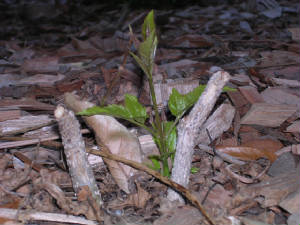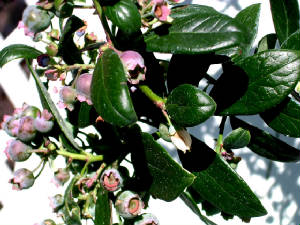|
|
 |
|
Gardening Blog
|
 |
|
|
Saturday, March 20, 2010
Spring has Sprung!
Spring is finally here and it seems that the weather is cooperating too. After such a
damaging cold winter, we have lots to do to get our landscapes back in shape. Plants should be starting to sprout new growth
so that we can finally determine the extent of the freeze damage. This is the time of year when we want
to refresh the landscape by pruning away any freeze damage, cleaning up plant debris that collected under plants during the
winter, planting annuals for spring and summer, and applying a fresh layer of mulch.
Freezing temperatures caused many lawns to turn brown especially in areas that were the most
exposed. You should be seeing new growth from the grass that is still living by now. You
might find that there are areas that will need new sod or plugs to repair areas that are do not sprout. Do
not "scalp" the lawn to remove the grass that has turned brown. You may remove living growing
points that are protected by the brown grass blades. Wait until you see good green growth to put down fertilizer.
Use a product with 50% slow release nitrogen in a formula like 15 - 0 -15. Pinellas County has passed
a fertilizer ordinance that will ban fertilizer usage on lawns from June 1 – September 30, so using a slow release fertilizer
is very important. Remember to mow your grass at the highest recommended height for your grass type.
Plants that were damaged should be sprouting now. Prune these plants back to healthy sprouting buds that are growing to the outside of the plant by making pruning cuts at a slight angle about ¼ inch above the
bud. Some plants might not show any new growth. You should wait to see if these plants
sprout from the base or roots. You might need to prune the entire stems back to this growth area.
If you are living in Northeast Pinellas County, you may want to consider replacing some of the sub-tropical plants
that were heavily damaged with plants more appropriate for our hardiness zone 9b. You can find a Florida-friendly
plant database at: http://www.floridayards.org/fyplants/index.php buds that are growing to the outside of the plant by making pruning cuts at a slight angle about ¼ inch above the
bud. Some plants might not show any new growth. You should wait to see if these plants
sprout from the base or roots. You might need to prune the entire stems back to this growth area.
If you are living in Northeast Pinellas County, you may want to consider replacing some of the sub-tropical plants
that were heavily damaged with plants more appropriate for our hardiness zone 9b. You can find a Florida-friendly
plant database at: http://www.floridayards.org/fyplants/index.php
Most leaves can be left on the ground and covered with new mulch. They
will add to the organic matter in the soil as they decay. If plants showed signs of disease or there is
fruit on the ground, cleaning up this debris is perhaps the single most important thing you can do to manage many of the leaf-spotting,
powdery mildew, bud and flower blight, and canker causing fungi. Many of these fungi overwinter on plant debris. Wind, irrigation
and rain can disseminate spores from this over wintering fungi to other areas of the garden or landscape.
Camellias and azaleas are susceptible to petal blight causing the flowers to turn brown and rot prematurely.
All fallen buds, flowers or petals should be removed from under the plants as soon as possible. On
camellias especially, if buds or flowers turn brown on the plant, remove as soon as you notice them.
Contaminated tools can also contribute to the spread of disease. Tools used to prune plants should be disinfected after
each use by dipping the cutting surfaces in a solution of one part bleach to nine parts water. Rubbing
alcohol (70%) from the drug store will also work and does not require diluting. If you have a lawn service
that does your pruning, ask that they disinfect their tools prior to using them in your yard.
In perennial beds you should start to see new growth.
Remove old flower heads, stalks, and any diseased plant parts. Examine roses for dead canes and remove them and prune
other canes back to where you see healthy new growth if this was not done earlier.
Annuals
planted in the fall, such as snapdragons, petunias, pansies or geraniums, will benefit from a light pruning and an application
of balanced slow release fertilizer. You should see a new flush of blooms that lasts into May.
Gazania, Marguerite Daisy, Marigold, Pentas, Salvias, Dianthus, and narrow-leaf Zinnia are some good annuals to plant
in April for color through spring and into the summer. Gaillardia is a really drought tolerant native flower
that can be seeded directly into the ground near the end of March that will provide drought tolerant flowers all summer long.
If you have shady areas where you want some color; select Caladium bulbs as soon as they are available for wonderful
leaf colors.
When all of your clean up efforts are finished,
put down a fresh layer of mulch. Be careful to keep the mulch a couple of inches away from the base of
plants and not more than two to three inches deep. It is not necessary to remove old mulch beyond raking
up diseased leaves and plant debris. Old mulch continues to decay, releasing organic matter and nutrients
into the soil.
A beautiful garden takes a lot of work, but you should be rewarded with results that
are worth the effort!
Thursday, March 4, 2010
Growing Blueberries in Containers
 Growing blueberries in Florida’s sandy soils is sometimes problematic since the pH of our soil tends toward neutral
or alkaline. Blueberries require an acid pH soil. But,
you can grow them in pot by using a soil mixture created to provide the perfect acidic pH environment that they require. Growing blueberries in Florida’s sandy soils is sometimes problematic since the pH of our soil tends toward neutral
or alkaline. Blueberries require an acid pH soil. But,
you can grow them in pot by using a soil mixture created to provide the perfect acidic pH environment that they require.
There are some cautions
however. There are two species of blueberries that grow well in Florida
– Rabbiteye and Southern Highbush. For the Tampa Bay area the
Southern Highbush is the one to choose. These were bred to produce fruit
despite our warmish winters. I have seen both species for sale in the
Tampa Bay area, so buyer beware and read the labels carefully.
For the majority of blueberry bushes, you will need two different cultivars within the species
for cross pollination to set fruit. Choose the two cultivars carefully
by bloom time so that they will both be blooming at the same time. The
University of Florida/IFAS Blueberry Gardener’s Guide (http://edis.ifas.ufl.edu/MG359) lists cultivars and their bloom and fruit dates.
There is one exception to this two cultivar requirement – the Southern Highbush cultivar ‘Sunshine
Blue’ is self pollinating and also dwarf in size – just great for containers. They
are harder to find – a good source is Parks Seed by mail order in spring. In
addition, I found ‘Sunshine Blue’ plants for sale at Lowe’s on March 1st. ‘Sunshine
Blue’ grows about 3 – 4 feet tall and wide.
For planting, choose a large pot with good drainage holes in the bottom. A
good soil mixture is 1 part sand, 1 part peat and 1 part milled pine bark – adding some compost is also beneficial. Water is crucial, especially during the bloom and fruit season. But be careful to not overwater; root rots are a common cause of blueberry plant
death. Water only when the top 1 inch of soil is dry. Fertilize
cautiously also. Use a blueberry special or camellia – azalea
fertilizer in small amounts every two months from April through October. Do
not put fertilizer in the planting hole – it could burn the tender roots.
With proper care, you will be enjoying blueberries next year.
Happy gardening,
Pam
|
|
To subscribe to this blog - click on XML icon.
|
 |
|
|
|
 |
|
|
Pampered Gardeners LLC * Oldsmar, FL * USA * Phone: 727 483-3783 * pam@pamperedgardeners.com
|
|
|
 |

